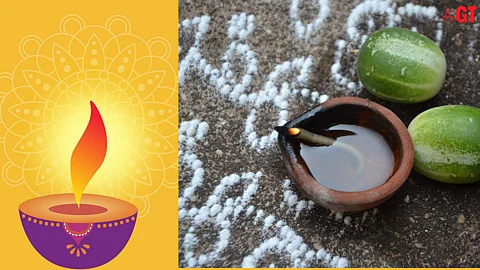

Nowadays, thanks to social media we are constantly made aware about special days and festivals. There’s another trend which is getting all the attention these days, and that is — how to have ‘eco-conscious’ celebrations. This is also true for Diwali celebrations — the ‘festival of lights’ which we are celebrating today.
It’s quite interesting that we now realize that we need to celebrate our festivals the eco-conscious way. But, if we look minutely, all our festivals, if celebrated in a traditional way, are exactly that!
NARKASUR: THEN & NOW
Speaking of Diwali, it is considered as the festival that celebrates the victory of good over evil. Thus, an effigy of the demon, Narkasur, is burnt in the wee hours on the big day. It is believed that Lord Krishna killed this demon.
However, nowadays, due to various Narkasur making competitions and sponsors, the demons are getting bigger and bigger. And, along with this, the use of firecrackers and other polluting material which is used to burn this effigy.
Traditionally, the demon was made from waste materials such as hay (which was easily available after the paddy harvest) and waste paper. There was barely any use of fireworks.
Now sadly, we have reduced this festival of lights to a ‘festival of fireworks’ and all the air and noise pollution that goes with it.
TRADITIONAL RITUALS
There are many rituals on the eve of Diwali along with Narkasur-burning. In some villages of Goa, (drinking water) wells, a pitcher and other utensils used for collecting water are worshipped.
They are decorated with the flowers and creepers of a karit (bitter wild gourd) fruit. This fruit has a lot of significance, and on the day of Diwali, this lime-sized fruit is crushed under the feet and its bitter juice is tasted.
I believe this ritual of worshipping water is an indication of the change of seasons, and this is the time of the year when the monsoon seasons ends and the dry season begins — and the water level goes down.
Thus, water bodies like wells and utensils for collecting water have much significance.
On the day of Diwali, a ritual bath is taken by applying oil and utne (herbal paste) on one’s body. It indicates a fresh start to the new season.
After the bath, all the members of the family assemble in the front yard, near the Tulsi vrindavan, and the lady of the family performs the aarti of each member.
After that, the karit fruit is crushed and its bitter juice is tasted. This indicates crushing of all negativities (like the destroying of narkasur), tasting its bitterness, and then moving ahead in life.
Also, this fruit is highly medicinal, it is anti-bacterial and its seeds have anthelmintic properties as these can treat parasitic worm infection.
After this ritual, it’s time to relish the delicious faraal, which contains various dishes made from fov, or flattened rice, as it is the season of paddy harvesting.
In the evening of Diwali day, Lakshmi Puja is generally held, and earthen diyas are lit at the entrance of the house. This is done to invite the goddess of prosperity into the house. One point to be noted here is that Diwali is held on new moon day, or amavasya, thus the lighting of lamps hold even more significance.
After the puja, puffed rice is distributed among the people. It is a fun activity for children to collect the puffed rice along with some goodies by visiting every shop, where the Lakshmi puja is mainly held.
As we know Diwali consists of a cluster of many festivals spread over six days. It starts with Vasu Baras where cows are worshipped. This is followed by Dhantrayodashi or Dhanteras, which is a celebration of the birth of the god of health. On this day, there is a custom of buying valuables such as gold, etc.
The next day is Narak Chaturdashi, followed by Laxmi Pujan. The day after that is known as Bali Pratipada, locally known as Padvo. It is a day dedicated to King Bali.
Dr Vidya Kamat from the Centre for the Study of Mythology and Culture, Goa, and Talking Myths Project, mentions that that Bali is considered the father of agriculture. “In Goa, Bali is still venerated in the form of a pole or stambha. Even today, the Kulmi community offers coconut water over the pole/linga on auspicious days,” says Kamat.
She further informs that the fishing communities in Goa consider King Bali as their ancestor and worship him as their god as well. She adds that the fishing community believes that they learnt the art of fishing from the son of Bali.
The last day of Diwali is observed as Bhai Duj or Bhau Bij, which is a celebration of the bond between brothers and sisters.
All these rituals, customs and traditions are an indication of the agrarian lifestyle of our ancestors, where they gave importance to each and every living being and celebrated its goodness. Such festivals help us understand that, in life, we should fight to retain the goodness of this world.
On that note, here’s wishing everyone a Happy Diwali!
Arti Das is a freelance journalist based in Goa. She loves writing about art, culture and the ecology of Goa.